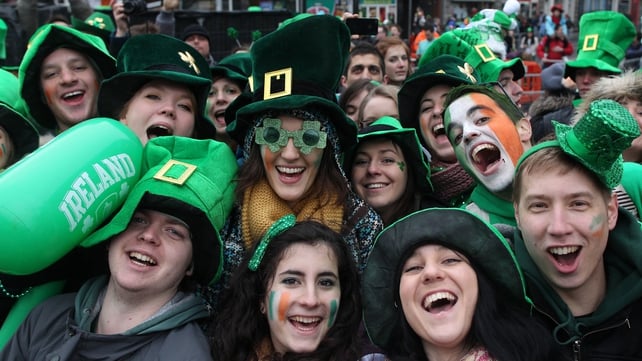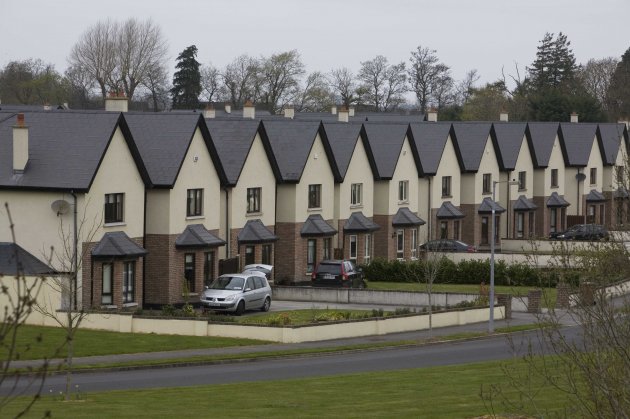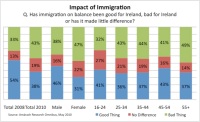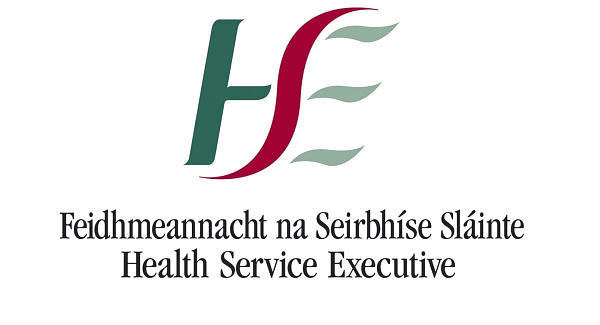Celebration events in Ireland and abroad for St Patrick’s Day


SPIRITS WERE HIGH IN DUBLIN DESPITE THE COLD AND WET WEATHER YESTERDAY SUNDAY ST. PATRICK’S DAY.
Parades and festivities marking St Patrick’s Day have taken place at home and abroad.
Organisers of the parade in Dublin said 483,000 people attended the event in the city today.
The weather appears to have affected the attendance, which was down on last year.
But there was plenty of colour, music and dance for those who turned out in the cold and rain to watch the parade.
It was preceded by a ‘People’s Parade’, in which thousands of foreign visitors took part.
It was part of the Government’s tourism initiative “The Gathering”.
“Great things happen when we come together” was the theme of this year’s event, which ended just past St Patrick’s Cathedral.
Elsewhere, Mayor of San Francisco Edwin Lee was the Grand Marshall of the Cork city parade, which attracted over 60,000 people.
Over 4,000 participants took part in the parade in Limerick, as the city attempted a new world record.
Over 285 St Patricks of all ages and sizes from right across the city gathered to create a new record for the Guinness Book of Records.
An estimated 40,000 people came out to watch the parade.
The parade in Belfast was smaller than in recent years, but still attracted a good crowd.
Businesses welcomed the large crowds after recent months of falling trade due to the ongoing Union flag protests.
The Union flag was flying over Belfast City Hall today.
Galway hosted its 110th St Patrick’s Day parade with participants of all ages showcasing the city’s history and traditions.
In Kerry, thousands turned out to watch parades in Killarney and Tralee.
Taoiseach Enda Kenny has met some of the victims of Hurricane Sandy near New York.
Mr Kenny went to the Breezy Point district to see the progress of the recovery effort following the devastating storm late last year.
He also visited the Freedom Tower in New York, which is replacing the World Trade Center towers that were destroyed on 11 September 2001.
Around the world, almost 70 landmarks have also “gone green” to celebrate the day.
Organisers of the parade in Dublin said 483,000 people attended the event in the city today.
The weather appears to have affected the attendance, which was down on last year.
But there was plenty of colour, music and dance for those who turned out in the cold and rain to watch the parade.
It was preceded by a ‘People’s Parade’, in which thousands of foreign visitors took part.
It was part of the Government’s tourism initiative “The Gathering”.
“Great things happen when we come together” was the theme of this year’s event, which ended just past St Patrick’s Cathedral.
Elsewhere, Mayor of San Francisco Edwin Lee was the Grand Marshall of the Cork city parade, which attracted over 60,000 people.
Over 4,000 participants took part in the parade in Limerick, as the city attempted a new world record.
Over 285 St Patricks of all ages and sizes from right across the city gathered to create a new record for the Guinness Book of Records.
An estimated 40,000 people came out to watch the parade.
The parade in Belfast was smaller than in recent years, but still attracted a good crowd.
Businesses welcomed the large crowds after recent months of falling trade due to the ongoing Union flag protests.
The Union flag was flying over Belfast City Hall today.
Galway hosted its 110th St Patrick’s Day parade with participants of all ages showcasing the city’s history and traditions.
In Kerry, thousands turned out to watch parades in Killarney and Tralee.
Taoiseach Enda Kenny has met some of the victims of Hurricane Sandy near New York.
Mr Kenny went to the Breezy Point district to see the progress of the recovery effort following the devastating storm late last year.
He also visited the Freedom Tower in New York, which is replacing the World Trade Center towers that were destroyed on 11 September 2001.
Around the world, almost 70 landmarks have also “gone green” to celebrate the day.
Irish Tax hits wrong people the wrong way at the wrong time


Self-assessment of property value places too much responsibility on taxpayers,
Your property is worth whatever you think it is. Forget the Revenue guide, it doesn’t know much more than you do and probably knows a whole lot less. It was too much to expect the Revenue to say how much property tax you should pay. After all, its job is to collect tax. It has more power than it needs to get the job done and will do whatever it takes.So it’s back to square one for most of us. If you’ve already tried the Revenue’s online help facility tovalue your property you will know it is not reliable. If it worked, every estate agent in the country would have had one, long ago. It’s up to you to come up with the figures, or pay an expert to have a guess instead.
But don’t panic yet. If everyone takes a reasonable approach, there should be no wrong answers. Unfortunately, tax law is not based on common sense or fairness, so people are genuinely concerned that what they come up with might be rejected. Don’t expect to get it right, but try to be in line with everybody else. The Revenue’s online valuation tool has used the same value for dissimilar properties, and that’s not good enough if you want to pay the right tax.
There are three things you can do to make a stab at valuing it yourself. Check what your property is worth according to the Revenue website. I assume this will be the value it will use when it writes to you. You can get the same information through certain Revenue offices or Citizens Information. Secondly, you can find out what properties were sold for in your area since January 2010 at http://www.propertypriceregister.ie. Finally, local knowledge and publications can help. Are there any properties for sale in the area, and at what price? What do you and your neighbours think the price should be?
When interviewed recently, Josephine Feehily, the chairman of the Revenue Commissioners, said that overvaluation wouldn’t be a problem. But she was wrong. Many people, older people in particular, are worried and stressed that they might not pay enough. They thought that they could have relied on the Revenue tax estimate, but they can’t. They would prefer not to pay the tax, but if they must, they want to get it right so that the Revenue doesn’t treat them like tax dodgers. After all, they are not expert valuers. Who is anymore?
Property prices are changing and there will always be a need to estimate, but the timing couldn’t be worse to bring in this new tax. The market is too volatile and people have enough to cope with. This is creating stress and impeding consumer confidence, so that foreign banks can get off the hook.
You can always get a professional valuation. It has been suggested that they can be had for between €90 and €120. Just imagine, estate agents could earn €160,000,000, so that the taxman can collect €250,000,000.
The Revenue itself accepts that 50 per cent of the valuations are wrong, but who really knows? If concerns are right, it could collect more than the €250,000,000 it has targeted, as confused taxpayers overpay to avoid the hassle. If Revenue gets what it wants, it is unlikely it will waste scarce resources looking for more, but when you sell your house, that’s when the trouble begins. The Revenue could get another bite of the cherry if it turns out you were off the mark.
As the chairman said, the Revenue have made it easy to pay, it’s almost impossible to avoid. Even if you can’t afford it, the Revenue will get it eventually – and with interest and maybe penalties.
The Government will get the money that the Troika said it must. The Revenue will get what it wants too: more information about property ownership than it could ever have uncovered itself. It’s a pity it couldn’t have done it better. It’s the wrong time, it’s the wrong way and the wrong people are being asked to pay.
A simple solution to the confusion that the valuation mechanism has caused would be to allow people to review their figures after everyone has filed their returns. The Revenue might do that, and it would make sense if it did. But does it trust the public to do the right thing, without the threat of punishment if they get it wrong?
The returns must be filed in May, so there is no reason why the Revenue could not update the website to reflect the information gathered. It also needs to allow for more information (such as number of rooms and enhancements) so that the online guide is more than an information-gathering tool for itself. While the information might not be available now, it will be once the returns are completed. The Revenue should publish it, if it wants the majority on its side.
Even in the good times, estate agents didn’t know what your house would sell for. How can anyone be expected to know if the price is right now? If you start with what the Revenue suggests, consider what others are looking for and add in what you think yourself, you can make a good estimate and that should be enough to satisfy the taxman.
It would be interesting to know how many tax officials get it wrong. They will have the same problem as everyone else, but they might be better informed.
Self-assessment places too much responsibility on taxpayers, with no scope to resolve any problems using common sense. With more than a million new taxpayers under scrutiny, this might change, even if I don’t think so myself. You have until May to get it right.
If you have avoided contact with Revenue until now, this might be the time to claim back any income tax you overpaid. Those unclaimed health expenses might be worth looking into. You can go back four years.
You might get enough back to pay the property tax.
New trends in emigration by Irish people


The age profile of emigrants is rising, as is the number of families emigrating. Part one of a Generation Emigration special looks at changing migration patterns.
At the Working Abroad Expo in the RDS in Dublin this month, mechanics and plumbers lined up alongside bankers and nurses looking for information about opportunities abroad. Graduates chatted excitedly about working holidays abroad, couples pushing buggies asked about schools in places they had never been, and men in their 50s inquired about emigrating for the second or third time in their lives. It was as close a snapshot of current migration trends as you could find.David Walsh started the event nine years ago to provide young graduates with advice about working in Australia. Now it’s a major jobs fair, featuring companies from all over the world.A Canadian immigration official attended in 2009 and liked what he saw, and the following year a small delegation of immigration officials and employers was sent to represent Canada. This year Canadian companies took up more than half of the exhibition stands.
“The most noticeable trend over the past 12 months has been the swing away from Australia towards Canada, which has been driven by the demand from employers and from the Canadian department of immigration,” says Walsh. “They are going through a skills shortage, and in Calgary, the economic heartland of Canada, 19 of the 25 skillsets most in demand are readily available in Ireland. ”
The interest in Canada among potential emigrants has been increasing in line with Canadians’ interest in us. Six hundred and sixty-two Irish people were granted permanent residency in Canada in 2011, up from just 314 in 2006, and 5,293 temporary workers entered the country from Ireland in the same year, up from 1,970 five years previously.
When the application system for Canadian working-holiday visas for this year opened to Irish people at the end of January, the quota of 6,350 was filled in 48 hours. The quota for 2014 will be expanded to 10,700.
Cathy Murphy, the director of the Irish Canadian Immigration Centre in Toronto, estimates that more than half of the visa quota went to Irish people already in Canada who were applying to stay for a second year.
There have been notable changes since the centre opened, 12 months ago. “The number of people coming in looking for information about permanent residency even since January has been incredible,” says Murphy. The centre is also dealing with more queries from families in Ireland looking for information about schools and housing. “There has been a definite shift in the last six months towards people in their late 30s and early 40s.”
Rising age profile
Everyone who speaks to The Irish Times for this article says the rising average age of emigrants and the number of families leaving are the most notable trends of recent months.
Of the 527 people at the Working Abroad Expo who responded to a survey by University College Cork ’s Emigre project that traces recent emigration patterns, 44 per cent were over 30, and 14 per cent were 40 or older. More than one in five had mortgages in Ireland, and 27 per cent had children.
“The striking thing to me when we compare this cohort with the emigrants of the 1980s is the age profile,” says Dr Piaras Mac Éinrí, who leads the Emigre project. “More couples with young children are leaving as a family unit, which is not a traditional feature of Irish emigration.
“They might be less likely to return. Those who leave in their early 20s are likely to be only in their early 30s if and when the economy turns around, and there’s more of a chance they will come back if circumstances are favourable. About half of those who left in the 1980s did. But a family who are in their 30s already, whose kids are growing up in another place, are much less likely to come back.”
Another finding of MacÉinrí’s survey was that almost half of all respondents were in full-time employment in Ireland, but two-thirds cited dissatisfaction with their career prospects as one of the main reasons for emigration.
Mac Éinrí, who is 58, was also struck by the number of men of about his own age at the fair. “It would be very tough for them to get visas for Australia or Canada. They are looking at a pretty bleak future. To emigrate is very tough for a lot of people, but to do so in your 40s or 50s, when you’ve never lived abroad, is a huge culture shock,” he says.
The Irish migration agency VisaFirst has also noticed significant trends over the past 12 months. The number of applications from teachers, welders, solicitors, mechanics and IT professionals, as well as from articulated truck drivers looking for jobs in Canada, it has dealt with has increased significantly, according to its manager, Edwina Shanahan.
The number of architects using its services has dropped by 80 per cent over the past 12 months – “They have all gone already,” says Shanahan – and the number of plumbers and electricians seeking help to move to Australia has fallen by about 20 per cent. “People in construction still form the highest proportion of our business, but teachers, nurses, people from civil service backgrounds and business managers from the banking sector are certainly on the rise.”
Despite the swing towards Canada, Australia remains popular, though there have been some significant demographic changes over the past 12 months or so, with the Irish population there maturing and becoming more permanent. With about 15,000 Irish people in Australia on working-holiday visas, Ireland has the fifth-highest representation of any country, though numbers might be declining.
Statistics published by the Australian department of immigration and citizenship last month show 6,504 Irish people were granted working-holiday visas for the first time between July and December last year, a decrease of 28.8 per cent on the same period in 2011.
According to Shanahan, young people are finding it harder to save money to go away on working holidays, and parents cannot afford to fund them to the same extent as before.
Desire for permanence.
The numbers successfully applying to stay on in Australia for a second year rose to 3,735 in the latter half of 2012, an increase of 33.7 per cent on the same period in 2011, indicating a desire for more permanence among the Irish population there.
The number of Irish workers granted four-year, employer-sponsored 457 visas is also on the up, increasing by 18.4 per cent to 3,670 in the second half of 2012. Significant numbers of sponsored Irish workers are also bringing their spouses and children to Australia, with more than 2,000 secondary 457 visas issued to their dependants during the same period.
Tomorrow, on St Patrick’s Day, 44 Irish people will be granted Australian citizenship, at ceremonies in Perth and Sydney, allowing them to stay in Australia indefinitely.
This will bring the total number of Irish who have secured Australian citizenship in the past six years to more than 7,000.
Australia, Canada and New Zealand are often the most talked-about destinations for Irish people looking to emigrate, but the UK still attracts the most migrants from Ireland. CSO f
igures show 19,000 Irish and other foreign nationals moved there in the 12 months prior to April 2012. It is likely that the UK has remained the most popular destination for migrants from Ireland in the year since then, although as visas are not necessary for Irish people it is difficult to know exactly how many are going.
Crosscare, an information and advocacy service for migrants run by the Dublin archdiocese, notes the growth of commuter migration over the past 12 months. It is becoming very common for workers to travel to the UK during the week and return to family at weekends or every few weeks, says Joe O’Brien, its policy director. “In most instances, the family are tied to Ireland because of a mortgage or it is seen as the preferable option to uprooting children and emigrating as a family unit. They can see it as a temporary arrangement, but often it lasts years.”
The Gulf states are attracting increasing numbers of experienced and highly skilled construction professionals lured over alone or with families by the promise of tax-free salaries and work on billion-dollar infrastructure projects. The Irish population in the United Arab Emirates has increased by 30 per cent, to an estimated 6,000, people in the past 18 months, while the number of Irish in Saudi Arabia has also risen, to about 3,000. Qatar, Kuwait, Oman and Bahrain are popular for similar reasons.
What is certain is that Irish people are still emigrating in large numbers. The most recent CSO figures show 46,500 Irish people left the country in the 12 months to April 2012, a rise of 16 per cent on the previous year and up from just 12,900 in 2007. We will have to wait until September for figures for the past 12 months, but a significant change seems unlikely.
The importance of getting enough vitamin D from your foods


Some people have heard a lot about vitamin D deficiency in the news recently, and the question asked is how much do I need and where can I get it?
Dr. K answers: I try to make things clear, but the value of vitamin D supplements is complicated. Here it is in a nutshell.
We get most of the vitamins we need in our diet. However, vitamin D is found naturally in only a few foods. Fatty fish is the main food source. Milk doesn’t naturally contain vitamin D, but it’s fortified with it. So are many juices and breakfast cereals.
We get most of our vitamin D from sunlight: When sun strikes the skin, certain cells make vitamin D.
But people get a lot less sunlight than they used to. It’s not just the concern about skin cancer; it’s mainly the fact that most of us spend much less time outdoors than our ancestors did. Throughout most of human history, humans spent much of the daytime outdoors. At the turn of the 20th century, more than 90 percent of U.S. citizens lived and worked on farms.
We didn’t know about vitamin D then and couldn’t measure blood levels. So we don’t know for sure, but most experts think that our blood levels of vitamin D today are likely much lower than our ancestors’.
Is that a problem? We know from epidemiologic studies that the risk of getting many important diseases — autoimmune diseases, heart disease, certain types of cancer — is greater among people whose blood levels of vitamin D are lower. Few people dispute that.
Here’s where the controversy begins. It is clear that taking vitamin D supplements can raise your blood levels. But it’s by no means clear that this is good for your health. Most experts agree that if your blood levels are lower than 20 ng/ml, you tend to develop thinning of the bones, and that taking vitamin D supplements can help protect you. But the value of vitamin D supplements for protecting you against other diseases is uncertain.
The current recommendation for vitamin D is 600 international units (IU) per day for people up to age 70, and 800 IU per day for those over age 70. Vitamin D comes in two forms: D3 and D2. If you take supplements, some experts recommend choosing one that contains D3.
Here’s the bottom line, at least for me: Get your vitamin D from foods. Avoid too much sun exposure, which can increase your risk of skin cancer. If your blood level of vitamin D is lower than 30 ng/ml, then I recommend you talk to your doctor about taking at least 1,000 IU a day.
HSE West mental health review in final stages


HSE West has confirmed that a review of mental health services in Galway and Roscommon is in its final stages and a report is expected to be published in the next three months.
Minister of State for Health Sean Sherlock made the admission during a debate in the Dáil on Thursday evening, after Galway Deputy Paul Connaughton raised the ongoing issue of Toghermore House in Ballinasloe.
Deputy Connaughton said that current review of mental health service being carried out by the HSE must be patient-focused and include proper representation for patients and their families.
“Any consultant psychiatrist involved in Toghermore House needs to be involved in this review and be given an opportunity to actively participate. We need to draw a line under this issue and secure the future of Toghermore House and make sure that patients are at the centre of any decision made and that all patients are given due consideration,” he said.
The Galway East TD outlined the recent history in relation to the house, including the fact that HSE West looked to close the residential part of the facility “on foot of what they said were fire safety issues”.
He also pointed to the spending of €1.4 million on the unit and asked when works currently underway on the house will be completed.
Responding to the issue on behalf of the Minister for Health James Reilly, Minister of State Sean Sherlock said that a local steering group met to address the issues and this included patient representatives.
He outlined some works due to take place at the facility, including the introduction of a fire system, and confirmed that the review of mental health services in Galway and Roscommon is currently being finalised by HSE West and would be completed in 12 weeks.
Deputy Connaughton expressed his disappointment that Ministers Reilly and Lynch were not present for the debate and said the Government could not have a situation “where they spend €1.4 million upgrading a facility and then two years later, another review of services is carried out”.
Why some ancient birds had four wings


Chinese paleontologists uncover evidence of back appendages made for flying
The white arrows indicate the preserved feathers of the specimen; the black arrows point to where feathers are absent.
Odern birds — especially species with big, majestic wingspans — are studies in aerodynamic efficiency, slicing through the air in ways our finest aircraft can’t. But it wasn’t always that way. Paleontologists in China have discovered that some long-forgotten ancestors of birds were endowed with a much more inefficient set-up: Four feathered limbs designed for flight.
By studying 11 fossils from the lower Cretaceous period 120 million years ago, scientists found clear evidence of hind wings on a few select species. “Modern birds generally work with two wings,” says Amina Khan at the Los Angeles Times, “using small, clawed hind legs for ground travel.”
A few, like the golden eagle, have fuzzy down on their back limbs, which is for insulating their appendages, not flying. Though researchers have unearthed evidence of downy limbs in feathered dinosaurs, little evidence existed that early birds were using those hind legs for flapping.
But 11 specimens from Liaoning in northeastern China, from several species show evidence of long, stiff feathers with curved shafts jutting out nearly perpendicular to the leg — a far cry from mere insulation.
According to the Chinese paleontologists, whose findings were published Thursday in the journal Science, the four-legged set-up “may have played an important role in the evolution of flight.” These early bird ancestors — species like Microraptor and Sinornithosaurs — were probably in the midst of learning how to use their hind limbs on the ground. Over time, these back wings might have evolved into more functional legs, thus allowing modern hawks to snatch up prey or robins to hunt for worms in the grass.
Lead researcher Zheng Xiaoting of the Shandong Tianyu Museum of Nature wrote that the hind wings were “aerodynamic in function, providing lift, creating drag and/or enhancing maneuverability, and thus played a role in flight.” The debate now, is exactly how these hind wings would have functioned.
In any case, this much is clear: These ancient, multi-winged creatures were probably more terrifying that we ever could have imagined.
No comments:
Post a Comment